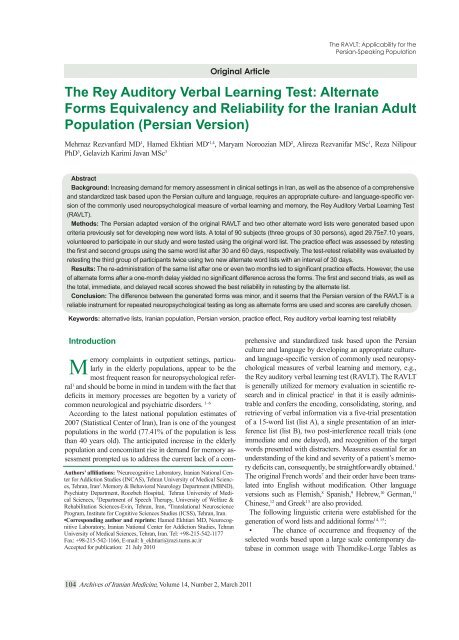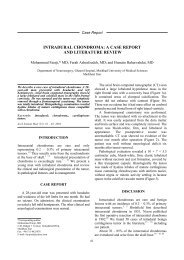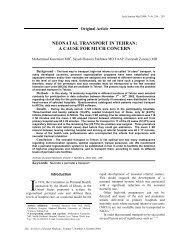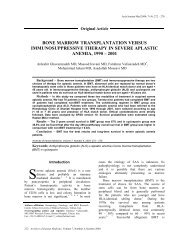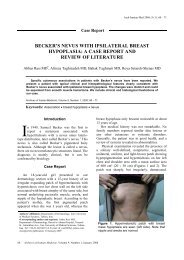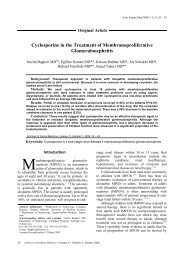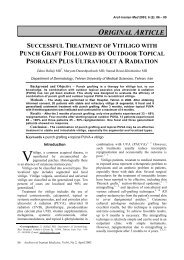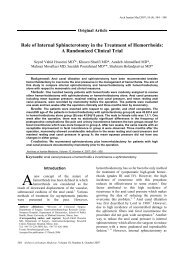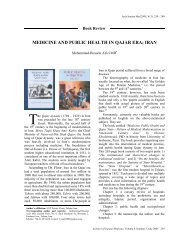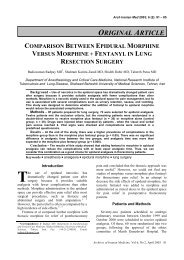The Rey Auditory Verbal Learning Test
The Rey Auditory Verbal Learning Test
The Rey Auditory Verbal Learning Test
Create successful ePaper yourself
Turn your PDF publications into a flip-book with our unique Google optimized e-Paper software.
<strong>The</strong> RAVLT: Applicability for thePersian-Speaking PopulationOriginal Article<strong>The</strong> <strong>Rey</strong> <strong>Auditory</strong> <strong>Verbal</strong> <strong>Learning</strong> <strong>Test</strong>: AlternateForms Equivalency and Reliability for the Iranian AdultPopulation (Persian Version)Mehrnaz Rezvanfard MD 1 , Hamed Ekhtiari MD •1,4 , Maryam Noroozian MD 2 , Alireza Rezvanifar MSc 1 , Reza NilipourPhD 3 , Gelavizh Karimi Javan MSc 3AbstractBackground: Increasing demand for memory assessment in clinical settings in Iran, as well as the absence of a comprehensiveand standardized task based upon the Persian culture and language, requires an appropriate culture- and language-specic versionof the commonly used neuropsychological measure of verbal learning and memory, the <strong>Rey</strong> <strong>Auditory</strong> <strong>Verbal</strong> <strong>Learning</strong> <strong>Test</strong>(RAVLT).Methods: <strong>The</strong> Persian adapted version of the original RAVLT and two other alternate word lists were generated based uponcriteria previously set for developing new word lists. A total of 90 subjects (three groups of 30 persons), aged 29.75±7.10 years,volunteered to participate in our study and were tested using the original word list. <strong>The</strong> practice effect was assessed by retestingthe rst and second groups using the same word list after 30 and 60 days, respectively. <strong>The</strong> test-retest reliability was evaluated byretesting the third group of participants twice using two new alternate word lists with an interval of 30 days.Results: <strong>The</strong> re-administration of the same list after one or even two months led to signicant practice effects. However, the useof alternate forms after a one-month delay yielded no signicant difference across the forms. <strong>The</strong> rst and second trials, as well asthe total, immediate, and delayed recall scores showed the best reliability in retesting by the alternate list.Conclusion: <strong>The</strong> difference between the generated forms was minor, and it seems that the Persian version of the RAVLT is areliable instrument for repeated neuropsychological testing as long as alternate forms are used and scores are carefully chosen.Keywords: alternative lists, Iranian population, Persian version, practice effect, <strong>Rey</strong> auditory verbal learning test reliabilityIntroductionAuthors’ afliations: 1 Neurocognitive Laboratory, Iranian National Centerfor Addiction Studies (INCAS), Tehran University of Medical Sciences,Tehran, Iran 2 . Memory & Behavioral Neurology Department (MBND),Psychiatry Department, Roozbeh Hospital, Tehran University of MedicalSciences, 3 Department of Speech <strong>The</strong>rapy, University of Welfare &Rehabilitation Sciences-Evin, Tehran, Iran, 4 Translational NeuroscienceProgram, Institute for Cognitive Sciences Studies (ICSS), Tehran, Iran.•Corresponding author and reprints: Hamed Ekhtiari MD, NeurocognitiveLaboratory, Iranian National Center for Addiction Studies, TehranUniversity of Medical Sciences, Tehran, Iran. Tel: +98-215-542-1177Fax: +98-215-542-1166, E-mail: h_ekhtiari@razi.tums.ac.irAccepted for publication: 21 July 2010Memory complaints in outpatient settings, particularlyin the elderly populations, appear to be themost frequent reason for neuropsychological referral1 and should be borne in mind in tandem with the fact thatdecits in memory processes are begotten by a variety ofcommon neurological and psychiatric disorders. 1–6According to the latest national population estimates of2007 (Statistical Center of Iran), Iran is one of the youngestpopulations in the world (77.41% of the population is lessthan 40 years old). <strong>The</strong> anticipated increase in the elderlypopulation and concomitant rise in demand for memory assessmentprompted us to address the current lack of a comprehensiveand standardized task based upon the Persianculture and language by developing an appropriate cultureandlanguage-specic version of commonly used neuropsychologicalmeasures of verbal learning and memory, e.g.,the <strong>Rey</strong> auditory verbal learning test (RAVLT). <strong>The</strong> RAVLTis generally utilized for memory evaluation in scientic researchand in clinical practice 1 in that it is easily administrableand confers the encoding, consolidating, storing, andretrieving of verbal information via a ve-trial presentationof a 15-word list (list A), a single presentation of an interferencelist (list B), two post-interference recall trials (oneimmediate and one delayed), and recognition of the targetwords presented with distracters. Measures essential for anunderstanding of the kind and severity of a patient’s memorydecits can, consequently, be straightforwardly obtained. 1<strong>The</strong> original French words 7 and their order have been translatedinto English without modication. Other languageversions such as Flemish, 8 Spanish, 9 Hebrew, 10 German, 11Chinese, 12 and Greek 13 are also provided.<strong>The</strong> following linguistic criteria were established for thegeneration of word lists and additional forms 14, 15 :• <strong>The</strong> chance of occurrence and frequency of theselected words based upon a large scale contemporary databasein common usage with Thorndike-Lorge Tables as104 Archives of Iranian Medicine, Volume 14, Number 2, March 2011
M. Rezvanfard, H. Ekhtiari, M. Noroozian, et al.guidelines. 16 Only the most frequent words were used becauseof word usage and the likelihood of recall effect. 17• <strong>The</strong> imagery value using Pavio’s Table. 18 Words withhigh rates of imagery value were selected.• Word length measured by the number of letters and syllables.Only one- or two-syllable nouns were used to generatethe lists.• Control of any obvious semantic ambiguity and/or phoneticsimilarities or associations between the words on thesame list.<strong>The</strong> assessment of change is often critical in the neuropsychologicalevaluation, whether in research or in clinicalsettings. <strong>The</strong> repeated use of instruments confounds this assessmentinasmuch as practice effects (gains in performanceby prior experiences with the test) have been demonstratedfor many measures. 19,20 Practice effects are particularly expectedwith memory testing on account of the fact that thelearning gained during the preliminary evaluations tends tobe transferred to the following ones. 14 A practice effect maybe related to the fact that patients explicitly remember testitems or the testing format (test sophisticated effects) previouslypresented. 21 It is possible to minimize the practice effectby using alternate forms of a test instead of retesting bythe same form. 9,20 Several alternative forms have been developedfor the RAVLT such as those created by: Lezak; Shapiroand Harrison; Crawford et al.; Majdan et al.; and Geffenet al. 1,14,15,22 <strong>The</strong>y have been proven useful, particularly inlongitudinal or sequential research designs where baselineperformance, experimental manipulation, and recovery timeare expected to feature within clinical populations.Measurement error is another effect of signicance in sofar as it can bafe a patient’s actual score in a test-retest designeven when alternative forms are employed. Measurementerror is often construed as the concept of reliability,which incorporates test-retest reliability (TRR). A score witha good TRR is free of measurement error unrelated to chancevariance, and the second session of testing is likely to resultin subjects having scored the highest remaining amongst thebest. 20 It is also worthy of note that highly signicant reliabilitycoefcients were reported while studying different14, 20, 22alternative lists of the RAVLT.<strong>The</strong> present study aimed at developing a Persian version ofthe original word list of the RAVLT and two other alternateword lists from Lezak and Shapiro & Harisson, taking intoaccount the linguistic criteria specic to the Persian cultureand language settings. Practice effect was measured usingdifferent word lists at different retest intervals and alternateform reliability coefcients were evaluated for each trial.Materials and MethodsParticipantsNinety volunteers ages 18 to 50 (29.75±7.10 years) participatedin the study after providing written informed consent.<strong>The</strong> study population was comprised of 44 men and 46women, with educational levels ranging from 2 to 20 years(11.56±4.91). <strong>The</strong> exclusion criteria were history of brainsurgery or psychiatric symptoms and any type of medicalcondition or using a medication that might affect cognitivefunctioning.Word selection procedures<strong>The</strong> participants were assessed using the Persian adaptedlist of the RAVLT and two other alternate forms, (Lezak andShappiro & Harisson), based on the original English wordlists reviewed by Hawkins et al. (2004). 14 <strong>The</strong> original Englishwords, presented in Table 1, were initially translated intoPersian without any change. Of the 90 words from the sixoriginal English word lists, 80 which were in accordancewith desired linguistic criteria were retained from both listsA and B. Ten new words adapted to the Persian languagewere chosen for the development of the Persian lists. Finally,the word items on these newly formed Persian lists werecompared with the original lists for consistency in terms ofword length (as measured by number of phoneme counts inPersian), and all were one- or two-syllable concrete nouns.<strong>The</strong>re were no obvious semantic or phonetic associationsor similarities between the words on the same list and theywere chosen from amongst frequently occurring words inthe Persian language. <strong>The</strong> probability of the occurrence ofthe word in common usage in the Persian language was ascertainedusing the World Wide Web (WWW) as a database(from six billion contemporary Persian words on four millionwebsites), Google as the search engine, and a Googlebasedapplet, which provided word counts on the Webpages. This method was also employed by Cilibrasi (2007) 23to automatically compute the similarity distance betweenwords and phrases, and its performance was in agreementwith that of the Word Net database. Recognition lists wereconstructed using target words and adding 20 new semanticallyassociated or phonetically similar words as distracters.<strong>The</strong> above criteria helped establish form equivalence betweenthe three new lists.ProcedureAll tests were administered by qualied examiners (psychologyexperts) trained in AVLT administration at quiet locationsin accordance with Lezak’s instructions. 1 <strong>The</strong> participantswere screened at the beginning of the testing sessionfor exclusion criteria such as health problems via a standardizedinterview before being categorized into three groups of30 persons and matched based upon demographic variablesthat might affect performance on the auditory learning testsuch as age, gender, and education level. 6,24<strong>The</strong> rst group was tested based upon the Persian adaptedversion of <strong>Rey</strong>’s (word list 1) in two test sessions with intersessionintervals of 30 days (±3); the second group receivedthe <strong>Rey</strong>’s 60 days (±5) after the initial testing; andArchives of Iranian Medicine, Volume 14, Number 2, March 2011 105
WordFrequencyOriginal list 1(<strong>Rey</strong>)AdaptedPersianversionOriginal list 2(Lezak)Adapted PersianversionOriginal list 3(Shapiro &Harisson)AdaptedPersian list 3A B A B A B A B A B A BDrum Desk Book Bowel Street Baby Curtain Ranger Flower Down Grass Ocean Bell Bird Train Judge Door Palace Coffee Shoe Rug Grant Arm Lip School Stove Meadow Insect Star Bar Parent Mountain Harp Plane Wife Dress Moon Glasses Salt County Window Steam Garden Towel Finger Pool City Coin Hat Cloud Apple Seed Pupil Rock Farmer Boat Chimney Sheep Cabin Army Turkey Gum Log Coat Pipe Friend Color Pencil Key Bottle Skin Storm House Church Rattle Peach Fire Village River Fish Gold Chair Clock Cell Nose Lamb Button Meal Lake Building 9 AA4ATable 1. Item characteristics of the original AVLT and new adapted Persian word lists.7AA2 A10 AA5 A13 AA2 A6 AA3 A4 AA8 A13 AA2 A11 AA4 A11 AA4 A<strong>The</strong> RAVLT: Applicability for thePersian-Speaking Population10 AA5 AWord length5.1 5.0 5.0 5.1 4.9 4.8 4.9 5.7 4.5 4.9 5.4 5.3(mean)A: < 50 – 100 in 10 ^6 words; AA: >100 in 10 ^6 words14AA1 A13 AA2 Athe participants in the third group were evaluated in threetest sessions via the Persian adapted version of the <strong>Rey</strong>’s(word list 1), Lezak’s (word list 2), and Shapiro & Harisson’s(word list 3), respectively, with intersession intervalsof 30 days (±3). All tests and retests were performed in axed sequence (non-counterbalanced design), and the delayintervals were chosen on the basis of previous literature. 25Description of the auditory verbal learning test and relatedmeasures<strong>The</strong> test was administered in accordance with the proceduredescribed by Lezak (2004). 1 In brief, subjects are askedto recall as many words on an initial oral 15-word list (list A)as possible, in any order. This procedure was repeated vetimes consecutively (trials 1 – 5 or acquisition trials), withthe score for each trial being the number of words correctlyrecollected.Participants were subsequently presented with a second list(list B); which was a measure of proactive interference, orthe degree to which old learning can meddle with new learning.In the next step, participants were asked to remember asmany words from list A as possible without reading it again;or immediate recall (ImmRec) and is believed to stimulate aretroactive interference situation in which new learning tangleswith the recollection of old information. Delayed freerecall (DelRec) was thereafter administered to the participantsin the same manner as ImmRec (e.g., no access to listA) but following a 20 minute time interval. Subjects werethen presented with a yes/no recognition trial of 50 wordscomprised of 15 target words from list A, 15 words from listB, and 20 words similar to word lists A and B in phonologicalor semantic terms.<strong>The</strong> immediate memory span is usually measured basedon the number of words recollected on the rst trial (Trial1). <strong>The</strong> learning curve is the variation in performance overthe course of the ve free-recall trials, with its slope providinga measure of the verbal learning test. 26 This slope isgenerally characterized as the difference between recall onthe fth trial and that on the rst trial (Trial 5-Trial 1). Serialpositions are obtained by adding up the number of words recalledacross the ve trials in blocks of three; in other wordsthey can make a total amount of fteen. Serial Position 1(SP1) to Serial Position 5 (SP5) are utilized by studying theserial positions of the words recalled across the trials. Normalsubjects are likely to recall the initial words (Primacy)but also the latest ones (Recency). 1<strong>The</strong> following is a list of other scores that are calculated:the total learning (TL=sum of words recalled in the ve106 Archives of Iranian Medicine, Volume 14, Number 2, March 2011
M. Rezvanfard, H. Ekhtiari, M. Noroozian, et al.Table 2. Descriptive statistics for the RAVLT scores and reliability coefcients in different test-retest administrations.RAVLTscoresInterval:1 month(n=30)Interval: 2 months (n=30)List 1 List 1 List 1 List 1 List 1 List 2 List 3Interval: 1 month(n=30) r 1-2r 1-3r 2-3ICCTrial 1 7.03(2.43) 9.40(2.55) *** 7.03(1.68) 9.20(1.94) *** 6.80(1.85) 7.27(2.24) 7.23(2.14) .69 ** .55 ** .56 ** .59 **Trial 2 9.83(2.32) 11.73(2.20) *** 9.33(2.15) 11.27(2.67) *** 9.87(2.10) 9.47(2.25) 9.93(2.16) .52 ** .64 ** .56 ** .58 **Trial 3 11.23(2.30) 12.77(1.81) *** 10.90(2.20) 12.50(1.60) *** 11.27(1.82) 11.23(2.25) 11.80(1.94) .48 ** .56 ** .61 ** .54 **Trial 4 12.23(2.24) 13.00(1.58) * 11.80(1.89) 12.77(1.45) ** 11.57(2.42) 11.77(2.33) 12.03(1.99) .51 ** .31 .59 ** .47 **Trial 5 12.57(1.98) 13.23(1.55) * 12.03(2.24) 13.33(1.50) *** 12.77(1.48) 11.93(2.08) 12.57(1.96) .42 * .38 * .57 ** .44 **Total 52.57(9.74) 58.07(13.03) ** 51.07(8.00) 59.03(6.24) *** 52.27(8.63) 51.63(9.54) 53.63(8.84) .55 ** .64 ** .77 ** .65 **List B 6.07(2.38) 6.50(2.62) 5.77(2.03) 6.73(2.27) 6.33(2.38) 6.20(2.04) 5.67(2.04) .56 ** .48 ** .62 ** .54 **Imm rec 11.73(2.27) 13.10(1.83) ** 10.80(2.41) 11.90(2.29) ** 11.23(2.58) 10.50(2.67) 11.63(2.34) .64 ** .51 ** .60 ** .56 **Del rec 11.27(2.57) 12.97(1.96) *** 10.90(3.15) 11.70(2.53) * 11.30(2.73) 11.20(2.87) 11.43(2.45) .66 ** .72 ** .71 ** .70 **HIT 14.3(1.22) 14.50(0.86) 14.23(1.25) 14.37(0.96) 13.80(1.77) 13.77(1.60) 13.90(1.21) .44 * 47 ** .345 .42 **MISS 0.87(1.22) 0.50(0.86) 0.77(1.25) 0.63(0.96) 1.20(1.77) 1.23(1.60) 1.10(1.21) .44 * .47 ** .345 .42 **CR 33.77(1.80) 34.27(1.20) 33.93(1.64) 34.13(1.07) 33.60(2.17) 33.90(2.17) 33.50(2.94) .23 .22 .64 ** .37 **FA 1.23(1.80) 0.73(1.20) 1.07(1.63) 0.87(1.07) 1.40(2.17) 1.10(2.17) 1.33(2.20) .23 .31 .64 ** .40 **Derived scoresFAL 12.97(1.71) 13.53(1.46) * 12.40(2.39) 13.73(1.14) ** 12.97(1.54) 12.60(1.85) 1.69))13.10 .37 * .35 .62 ** .45 **Slop 5.93(1.88) 4.10(1.89) ** 5.60(1.83) 4.53(1.72) 6.16(1.41) 5.37(1.92) 1.89))5.87 .55 ** .02 .17 .19 *LOT 17.60(6.73) 12.87(6.26) * 15.57(7.74) 13.17(6.54) 18.27(5.04) 17.73(6.47) 5.57))17.13 .40 * .12 .28 .19 *FR 0.47(1.31) 0.27(0.87) -0.03(2.20) 0.20(1.69) -0.07(1.53) -0.50(1.50) 1.05))0.30 -.13 .35 .06 .08PI -.97(2.50) -2.90(1.90) ** -1.27(2.23) -2.47(2.30) * -6.43(2.25) -5.73(1.94) -6.90(2.06) .18 .14 .33 .20 *RI -.83(1.49) -1.33(0.94) -1.23(1.57) -1.40(1.60) -1.53(1.81) -1.43(1.55) -.93(1.51) -.33 -.05 -.002 -.11Age 31.63(8.48) 28.07(6.81) 31.23(5.20)Edu (yr) 10.50(6.21) 12.12(4.47) 12.00(3.47)Sex M/F% 50/50 50/50 46.7/53.3*P
<strong>The</strong> RAVLT: Applicability for thePersian-Speaking PopulationFigure 1. AVLT learning curves (a) andrecalled words serial positions (b) of testretestadministration of the same word list(<strong>Rey</strong>) after a 30-day (±3) delay (*P
M. Rezvanfard, H. Ekhtiari, M. Noroozian, et al.for verbal memory scores has also been observed for mosttests used in clinical practice. 30–32To sum up, there is enough data to suggest that the differencebetween forms is sufciently minor to be able to ignoreit in clinical application. It seems that the Persian version ofthe RAVLT is a reliable instrument for repeated neuropsychologicaltesting as long as alternate forms are used andscores chosen carefully. <strong>The</strong> results of the present study areuseful for both clinical trials and clinical purposes such aspre- and post-assessments. Be that as it may, prior to generalclinical application, normative data is required on largersamples of both clinical and normal subjects and for differentage groups and education levels. Multiple studies withcounter-balance design are needed to determine reliability,equivalency, and relative difculty levels more denitivelyamong different clinical populations.AcknowledgmentThis work was supported by a grant from Tehran Universityof Medical Sciences to Maryam Noroozian. We thankthe staff of INCAS neurocognitive laboratory for their helpin participant recruitment and management. We also thankGholamreza Esmaeeli Djavid for his consultations for statisticalanalysis. We declare no conicts of interest.References1. Lezak MD, Howieson DB, Loring DW. NeuropsychologicalAssessment. New York: Oxford University Press; 2004.2. Bozikas VP, Kosmidis MH, Kiosseoglou G, Karavatos A. Neuropsychologicalprole of cognitively impaired patients withschizophrenia. Compr Psychiatry. 2006; 47: 136 – 143.3. Schoenberg MR, Dawson KA, Duff K, Patton D, Scott JG, AdamsRL. <strong>Test</strong> performance and classication statistics for the<strong>Rey</strong> <strong>Auditory</strong> <strong>Verbal</strong> <strong>Learning</strong> <strong>Test</strong> in selected clinical samples.Arch Clin Neuropsychol. 2006; 21: 693 – 703.4. Mungas D. Differential clinical sensitivity of specic parametersof the <strong>Rey</strong> <strong>Auditory</strong>-<strong>Verbal</strong> <strong>Learning</strong> <strong>Test</strong>. J Consult ClinPsychol. 1983; 51: 848 – 855.5. Rosenberg SJ, Ryan JJ, Pritera A. <strong>Rey</strong> <strong>Auditory</strong>-<strong>Verbal</strong> <strong>Learning</strong><strong>Test</strong> performance of patients with and without memory impairment.J Clin Psychol. 1984; 40: 785 – 787.6. Messinis L, Tsakona I, Malefaki S, Papathanasopoulos P. Normativedata and discriminant validity of <strong>Rey</strong>’s <strong>Verbal</strong> <strong>Learning</strong><strong>Test</strong> for the Greek adult population. Arch Clin Neuropsychol.2007; 22: 739 – 752.7. <strong>Rey</strong> A. L ‘examen clinique en psychologie [Clinical tests in psychology].Paris: Presses Universitaires de France; 1964.8. Lannoo E, Vingerhhoets G. Flemish normative data on commonneuropsychological tests: inuence of age, education, andgender. Psychologica Belgica. 1997; 37: 141 – 155.9. Miranda JP, Valencia RR. English and Spanish versions of amemory test: word length effects versus spoken duration effects.Hisp Jl Behav Sci. 1997; 19: 171.10. Vakil E, Blachstein H. <strong>Rey</strong> <strong>Auditory</strong>-<strong>Verbal</strong> <strong>Learning</strong> <strong>Test</strong>:structure analysis. J Clin Psychol. 1993; 49: 883 – 890.11. Muller H, Hasse-Sander I, Horn R, Helmstaedter C, Elger CE.<strong>Rey</strong> <strong>Auditory</strong>-<strong>Verbal</strong> <strong>Learning</strong> <strong>Test</strong>: structure of a modiedGerman version. J Clin Psychol. 1997; 53: 663 – 671.12. Lee TMC. Normative Data: Neuropsychological Measures forHong Kong Chinese. Hong Kong: Neuropsychology Laboratory,<strong>The</strong> University of Hong-Kong; 2003.13. Messinis L, Tsakona I, Papathanasopoulos P. <strong>Rey</strong> <strong>Auditory</strong> <strong>Verbal</strong><strong>Learning</strong> <strong>Test</strong> (RAVLT): Normative data of commonly usedneuropsychological tests. Poster presented at the InternationalNeuropsychological Society, 34 th mid-year meeting. 2006.14. Hawkins KA, Dean D, Pearlson GD. Alternative forms of the<strong>Rey</strong> <strong>Auditory</strong> <strong>Verbal</strong> <strong>Learning</strong> <strong>Test</strong>: a review. Behav Neurol.2004; 15: 99 – 107.15. Shapiro DM, Harrison DW. Alternate forms of the AVLT: a procedureand test of form equivalency. Arch Clin Neuropsychol.1990; 5: 405 – 410.16. Thorndike EL, Lorge I. <strong>The</strong> Teacher’s Word Book of 30,000Words. New York: Teacher’s College, Columbia UniversityBureau of Publications; 1944.17. Anderson JR, Bower GH. Recognition and retrieval processesin free recall. Psychologica Rev. 1972; 79: 97 – 123.18. Paivio A, Yuille JC, Madigan SA. Concreteness, imagery, andmeaningfulness values for 925 nouns. J Exp Psychol. 1968;76(suppl): 1 – 25.19. Hawkins KA, Sayward H. Examiner judgment and actual stabilityof psychiatric inpatient intelligence quotients. Clin Neuropsychol.1994; 8: 394 – 404.20. Lemay S, Bedard MA, Rouleau I, Tremblay PL. Practice effectand test-retest reliability of intentional and executive testsin middle-aged to elderly subjects. Clin Neuropsychol. 2004;18: 284 – 302.21. Wilson BA, Watson PC, Baddeley AD, Emslie H, Evans JJ. Improvementor simply practice? <strong>The</strong> effects of twenty repeatedassessments on people with and without brain injury. J Int NeuropsycholSoc. 2000; 6: 469 – 479.22. Ryan JJ, Geisser ME, Randall DM, Georgemiller RJ. Alternateform reliability and equivalency of the <strong>Rey</strong> <strong>Auditory</strong> <strong>Verbal</strong><strong>Learning</strong> <strong>Test</strong>. J Clin Exp Neuropsychol. 1986; 8: 611 – 616.23. Cilibrasi RL. <strong>The</strong> Google similarity distance. IEEE Transactionson Knowledge and Data Engineering (TKDE). 2007; 19:370 – 383.24. Poreh A. Analysis of mean learning of normal participants onthe <strong>Rey</strong> <strong>Auditory</strong>-<strong>Verbal</strong> <strong>Learning</strong> <strong>Test</strong>. Psychol Assess. 2005;17: 191 – 199.25. Crawford JR, Stewart LE, Moore JW. Demonstration of savingson the AVLT and development of a parallel form. J ClinExp Neuropsychol. 1989; 1: 975 – 981.26. Mitrushina M, Boone KB, D’Elia LF. Handbook of NormativeData for Neuropsychological Assessment. New York: OxfordUniversity Press; 2006.27. Benedict RH, Zgaljardic DJ. Practice effects during repeatedadministrations of memory tests with and without alternateforms. J Clin Exp Neuropsychol. 1998; 20: 339 – 352.28. Fastenau PS, Hankins WT, McGinnis CS, Moy T, Richard M.Effects of alternate forms on retest effects in clinical testing. JInt Neuropsychol Soc. 2002; 8:151 – 161.29. Delaney RC, Prevey ML, Cramer J, Mattson RH. <strong>Test</strong>-retestcomparability and control subject data for the <strong>Rey</strong>-<strong>Auditory</strong><strong>Verbal</strong> <strong>Learning</strong> <strong>Test</strong> and <strong>Rey</strong>-Osterrieth/Taylor Complex Figures.Arch Clin Neuropsychol. 1992; 7: 523 – 528.30. Dikmen SS, Heaton RK, Grant I, Temkin NR. <strong>Test</strong>-retest reliabilityand practice effects of expanded Halstead-Reitan Neuropsychological<strong>Test</strong> Battery. J Int Neuropsychol Soc. 1999; 5:346 – 356.31. Mitrushina M, Satz P. Effect of repeated administration of aneuropsychological battery in the elderly. J Clin Psychol. 1991;47: 790 – 801.32. <strong>The</strong>isen ME, Rapport LJ, Axelrod BN, Brines DB. Effects ofpractice in repeated administrations of the Wechsler MemoryScale Revised in normal adults. Assessment. 1998; 5: 85 – 92.Archives of Iranian Medicine, Volume 14, Number 2, March 2011 109


